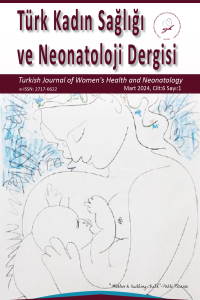Öz
Objective: In this study, we aimed to determine the incidence of incidental uterine anomalies in the patient population who gave birth in our centre and to evaluate the perinatal outcomes.
Methods: We conducted a retrospective analysis of outcomes of patients with incidental uterine anomalies who delivered at a tertiary care center between January 2023 and December 2023. Patient data were obtained by searching hospital records.
Results: The data of 782 pregnant women who had given birth in the last eleven months were analyzed retrospectively. Three patients were found who could be included in the classification of uterine anomaly and who had not received prior diagnosis and treatment. The mean age was 30.0 years and the mean body mass index was 25.6 kg/m2. The mean gestational age of the patients was 37+0 weeks.
Conclusion: In this study, we found uterine abnormalities in 3 patients during cesarean delivery. It is important to note that these uterine abnormalities correlate least with pregnancy complications or fertilization success.
Anahtar Kelimeler
congenital uterine anomalies malpresentation miscarriage Müllerian anomalies birth
Proje Numarası
-
Kaynakça
- Kachhawa G, Kriplani A. Management of Reproductive Tract Anomalies. J Obstet Gynaecol India. 2017;67(3):162-7. https://doi.org/10.1007/s13224-017-1001-8
- Chulani VL, Gordon LP. Adolescent growth and development. Prim Care. 2014;41(3):465-87. https://doi.org/10.1016/j.pop.2014.05.002
- Aplin JD, Myers JE, Timms K, Westwood M. Tracking placental development in health and disease. Nat Rev Endocrinol. 2020;16(9):479-94. https://doi.org/10.1038/s41574-020-0372-6
- Dietrich JE, Millar DM, Quint EH. Non-obstructive müllerian anomalies. J Pediatr Adolesc Gynecol. 2014;27(6):386-95. https://doi.org/10.1016/j.jpag.2014.07.001
- Pfeifer SM, Attaran M, Goldstein J, et al. ASRM müllerian anomalies classification 2021. Fertil Steril. 2021;116(5):1238-52. https://doi.org/10.1016/j.fertnstert.2021.09.025
- Grimbizis GF, Di Spiezio Sardo A, Saravelos SH, et al. The Thessaloniki ESHRE/ESGE consensus on diagnosis of female genital anomalies. Hum Reprod. 2016;31(1):2-7. https://doi.org/10.1093/humrep/dev264
- Cunha GR, Robboy SJ, Kurita T, et al. Development of the human female reproductive tract. Differentiation. 2018;103:46-65. https://doi.org/10.1016/j.diff.2018.09.001
- Bhagavath B, Ellie G, Griffiths KM, et al. Uterine Malformations: An Update of Diagnosis, Management, and Outcomes. Obstet Gynecol Surv. 2017;72(6):377-92. https://doi.org/10.1097/OGX.0000000000000444
- Hosny AEMS, Fakhry MN, El-Khayat W, Kashef MT. Risk factors associated with preterm labor, with special emphasis on preterm premature rupture of membranes and severe preterm labor. J Chin Med Assoc. 2020;83(3):280-7. https://doi.org/10.1097/JCMA.0000000000000243
- Mentessidou A, Mirilas P. Surgical disorders in pediatric and adolescent gynecology: Vaginal and uterine anomalies. Int J Gynaecol Obstet. 2023;160(3):762-70. https://doi.org/10.1002/ijgo.14362
- Jayaprakasan K, Ojha K. Diagnosis of Congenital Uterine Abnormalities: Practical Considerations. J Clin Med. 2022;11(5):1251. https://doi.org/10.3390/jcm11051251
- Mørk N, Lauszus FF, Agha Krogh RH. Congenital uterine anomalies and their association with fertility and pregnancy outcomes. Ugeskr Laeger. 2018;180(40):V02180149.
- Oppelt P, von Have M, Paulsen M, et al. Female genital malformations and their associated abnormalities. Fertil Steril. 2007;87(2):335-42. https://doi.org/10.1016/j.fertnstert.2006.07.1501
Öz
Amaç: Bu çalışma ile merkezimizde doğum yapan hasta popülasyonunda insidental uterin anomali insidansını belirlemek ve perinatal sonuçlarını değerlendirmeyi amaçladık.
Gereç ve Yöntem: Ocak 2023 ile Aralık 2023 tarihleri arasında üçüncü basamak bir merkezde doğum yapan ve tesadüfi uterin anomalisi olan hastaların sonuçları retrospektif olarak analiz edilmiştir. Hastaların verileri hastane kayıtları taranarak tespit edilmiştir.
Bulgular: Son on bir ay içinde doğum yapmış 782 gebenin verileri retrospektif olarak analiz edildi. Uterin anomali sınıflamasına dahil edilebilecek ve daha önce tanı ve tedavi almamış üç hasta bulundu. Ortalama yaş 30.0 yıl ve ortalama vücut kitle indeksi 25.6 kg/m2 idi. Hastaların ortalama gebelik yaşı 37+0 hafta idi.
Sonuç: Bu çalışmada, sezaryen doğum sırasında 3 hastada uterus anomalileri saptadık. Bu uterus anormalliklerinin gebelik komplikasyonları veya fertilizasyon başarısı ile en az korelasyon gösterdiğine dikkat etmek önemlidir.
Anahtar Kelimeler
konjenital uterus anomalileri malprezantasyon düşük Müllerian anomalileri doğum
Etik Beyan
Bu araştırma için Etlik Zubeyde Hanım Kadın Sağlığı Eğitim ve Araştırma Hastanesi Girişimsel Olmayan Çalışmalar Etik Kurulundan onay alınmıştır (Karar no:11/11 23.11.2023).
Destekleyen Kurum
Yok
Proje Numarası
-
Teşekkür
Yok
Kaynakça
- Kachhawa G, Kriplani A. Management of Reproductive Tract Anomalies. J Obstet Gynaecol India. 2017;67(3):162-7. https://doi.org/10.1007/s13224-017-1001-8
- Chulani VL, Gordon LP. Adolescent growth and development. Prim Care. 2014;41(3):465-87. https://doi.org/10.1016/j.pop.2014.05.002
- Aplin JD, Myers JE, Timms K, Westwood M. Tracking placental development in health and disease. Nat Rev Endocrinol. 2020;16(9):479-94. https://doi.org/10.1038/s41574-020-0372-6
- Dietrich JE, Millar DM, Quint EH. Non-obstructive müllerian anomalies. J Pediatr Adolesc Gynecol. 2014;27(6):386-95. https://doi.org/10.1016/j.jpag.2014.07.001
- Pfeifer SM, Attaran M, Goldstein J, et al. ASRM müllerian anomalies classification 2021. Fertil Steril. 2021;116(5):1238-52. https://doi.org/10.1016/j.fertnstert.2021.09.025
- Grimbizis GF, Di Spiezio Sardo A, Saravelos SH, et al. The Thessaloniki ESHRE/ESGE consensus on diagnosis of female genital anomalies. Hum Reprod. 2016;31(1):2-7. https://doi.org/10.1093/humrep/dev264
- Cunha GR, Robboy SJ, Kurita T, et al. Development of the human female reproductive tract. Differentiation. 2018;103:46-65. https://doi.org/10.1016/j.diff.2018.09.001
- Bhagavath B, Ellie G, Griffiths KM, et al. Uterine Malformations: An Update of Diagnosis, Management, and Outcomes. Obstet Gynecol Surv. 2017;72(6):377-92. https://doi.org/10.1097/OGX.0000000000000444
- Hosny AEMS, Fakhry MN, El-Khayat W, Kashef MT. Risk factors associated with preterm labor, with special emphasis on preterm premature rupture of membranes and severe preterm labor. J Chin Med Assoc. 2020;83(3):280-7. https://doi.org/10.1097/JCMA.0000000000000243
- Mentessidou A, Mirilas P. Surgical disorders in pediatric and adolescent gynecology: Vaginal and uterine anomalies. Int J Gynaecol Obstet. 2023;160(3):762-70. https://doi.org/10.1002/ijgo.14362
- Jayaprakasan K, Ojha K. Diagnosis of Congenital Uterine Abnormalities: Practical Considerations. J Clin Med. 2022;11(5):1251. https://doi.org/10.3390/jcm11051251
- Mørk N, Lauszus FF, Agha Krogh RH. Congenital uterine anomalies and their association with fertility and pregnancy outcomes. Ugeskr Laeger. 2018;180(40):V02180149.
- Oppelt P, von Have M, Paulsen M, et al. Female genital malformations and their associated abnormalities. Fertil Steril. 2007;87(2):335-42. https://doi.org/10.1016/j.fertnstert.2006.07.1501
Ayrıntılar
| Birincil Dil | İngilizce |
|---|---|
| Konular | Kadın Hastalıkları ve Doğum |
| Bölüm | Araştırma Makalesi |
| Yazarlar | |
| Proje Numarası | - |
| Yayımlanma Tarihi | 25 Mart 2024 |
| Gönderilme Tarihi | 24 Şubat 2024 |
| Kabul Tarihi | 29 Şubat 2024 |
| Yayımlandığı Sayı | Yıl 2024 Cilt: 6 Sayı: 1 |


